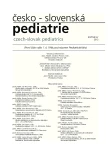Cardiovascular disease in Turner syndrome
Authors:
E. Klásková 1; Z. Tudos 2; J. Wiedermann 1; M. Šnajderová 3; J. Zapletalová 1
Authors‘ workplace:
Dětská klinika, FN a LF UP, Olomouc, přednosta prof. MUDr. V. Mihál, CSc.
1; Radiologická klinika, FN a LF UP, Olomouc, přednosta prof. MUDr. M. Heřman, Ph. D.
2; Pediatrická klinika UK 2. LF a FN Motol, Praha, přednosta prof. MUDr. J. Lebl, CSc.
3
Published in:
Čes-slov Pediat 2012; 67 (2): 103-111.
Category:
Review
Overview
Turner syndrome (TS) is relatively common disorder with typical features of short stature, gonadal dysgenesis and congenital defects of cardiovascular or uropoetic system.
Congenital cardiovascular disease affects approximately 50% of TS individuals and is the major cause of premature mortality due to the aortic dissection. Risk of acute aortic dissection is increased by more than 100-fold in young and middle-aged women with Turner syndrome when compare with the general population. Aortic dissection is usually associated with additional risk factors including bicuspid aortic valve or other abnormalities of the aortic valve, coarctation of aorta or dilatation of the ascending aorta, and systemic arterial hypertension.
In recent years, increasing numbers of women with TS have become pregnant via assisted reproduction. The risk for aortic dissection or rupture during pregnancy is 2% or higher. Because of this fact, the Practice Committee of the American Society for Reproductive Medicine recommended in 2005 a careful screening for cardiovascular abnormalities in all TS patients before any planned attempt at pregnancy. Women with any risk factors for aortic dissection should not undertake pregnancy.
The review describes the spectrum of cardiovascular defects with particular attention to identifying risk factor for aortic dissection. Authors suggest that all individuals with Turner syndrome require continued cardiovascular monitoring throughout the lifespan including new methods such as magnetic resonance imaging of the heart and great vessels.
Key words:
Turner syndrome, congenital heart defects, aortic coarctation, bicuspid aortic valve, ascending aorta dilatation, aortic size index, aortic dissection, arterial hypertension, pregnancy
Sources
1. Zapletalová J, Lebl J, Šnajderová M. Turnerův syndrom. Praha: Galén, 2003.
2. Sachdev V, Matura LA, Sidenko S, et al. Aortic valve disease in Turner syndrome. JACC 2008; 51 : 1904–1909.
3. Surerus E, Huggon IC, Allan LD. Turner’s syndrome in fetal life. Ultrasound Obstet Gynecol 2003; 22 : 264–267.
4. Boucher CA, Sargent CA, Ogata T, et al. Breakpoint analysis of Turner patients with partial Xp deletions: implications for the lymphoedema gene location. J Med Genet 2001; 38 : 591–598.
5. Clark EB. Neck web and congenital heart defects: A pathogenetic association in 45 X-0 Turner syndrome. Teratology 1984; 29 : 355–361.
6. Bondy CA. Congenital cardiovascular disease in Turner syndrome. Congenit Heart Dis 2008; 3 : 2–15.
7. Cleemann L, Mortensen KH, Holm K, et al. Aortic dimensions in girls and young women with Turner syndrome: A magnetic resonance imaging study. Pediatr Cardiol 2010; 31 (4): 497–504.
8. Carlson M, Silberbach M. Dissection of the aorta in Turner syndrome: two cases and review of 85 cases in the literature. J Med Genet 2007; 44 : 745–749.
9. Ho VB, Bakalov VK, Cooley M, et al. Major vascular abnormalities in Turner syndrome: Prevalence and magnetic resonance angiographic features. Circulation 2004; 110 : 1694–1700.
10. Ilyas M, Chu C, Ettles D, Mathew V, Atkin S. Evaluation by magnetic resonance imaging of aortic dilatation and coarctation in adult Turner syndrome patients. Clin Endocrinol 2006; 65 (2): 154–157.
11. Gravholt CH, Landin-Wilhelsemsen K, Stochholm K, et al. Clinical and epidemiological description of aortic dissection in Turner’s syndrome. Cardiol Young 2006; 16 : 430–436.
12. Lopez L, Arheart KL, Colan SD, et al. Turner syndrome is an independent risk factor for aortic dilatation in the young. Pediatrics 2008; 121: e1622–e1627.
13. Bondy CA. Aortic dissection in Turner syndrome. Curr Opin Cardiol 2008; 23 : 519–526.
14. Ostberg JE, Brookes JAS, McCarthy C, et al. A comparison of echocardiography and magnetic resonance imaging in cardiovascular screening of adults with Turner syndrome. J Clin Endocrinol Metabolism 2004; 80 (12): 5966–5971.
15. Mortensen KH, Hjerrild BE, Andersen NH. Abnormalities of the major intrathoracic arteries in Turner syndrome as revealed by magnetic resonance imaging. Cardiol Young 2010; 20 (2): 191–200.
16. Matura LA, Ho VB, Rosing DR, Bondy CA. Aortic dilatation and dissection in Turner syndrome. Circulation 2007; 116 : 1663–1670.
17. Lanzarini L, Larizza D, Prete G, et al. Prospective evaluation of aortic dimensions in Turner syndrome: A 2-dimensional echocardiographic study. J Am Soc Echocardiogr 2007; 20 (3): 307–313.
18. Hovatta O, Hreinsson J, Fridström M, et al. Fertility and pregnancy aspects in Turner syndrome. International Congress Series 2006; 185–189.
19. The Practice Committee of the American Society for Reproductive Medicine. Increased maternal cardiovascular mortality associated with pregnancy in women with Turner syndrome. Fertil Steril 2008; 90 (Suppl 3): 185–186.
20. Bondy CA, Rosing D, Reindollar R. Cardiovascular risks of pregnancy in women with Turner syndrome. Letter to the editor. Fertil Steril 2009; 91 (5): e31–e32.
Labels
Neonatology Paediatrics General practitioner for children and adolescentsArticle was published in
Czech-Slovak Pediatrics

2012 Issue 2
- What Effect Can Be Expected from Limosilactobacillus reuteri in Mucositis and Peri-Implantitis?
- The Importance of Limosilactobacillus reuteri in Administration to Diabetics with Gingivitis
Most read in this issue
- Transplantation of hematopoietic cells in five patients with chronic granulomatous disease in the Czech Republic
- Cardiovascular disease in Turner syndrome
- Poisoning of two boys by veterinary anesthetic – xylazine
- Growth and pubertal development of children with intrauterine growth retardation in the Moravian arm of ELSPAC study
